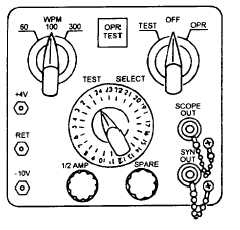Figure 1-22.-COMM interface No. 1.
over voice radio. Switches on the front of the box
provide control over data conversion,
TSEC/KW-7 Security Unit
This unit provides encryption and decryption of the
baudot code. It is used
operation.
TSEC/KWX-7 security
Unit (RCU)
whenever the teletype
Unit Remote Control
is in
This unit is located next to the TTY keyboard and
enables the operator to control the TSEC/KW-7 without
having to leave his/her seat.
Teleprinter Secure Interface
Mounted under the TTY keyboard, this unit
provides remote selection of secure or clear TTY
operation. By placing the red guarded TTY/TPR switch
to the BYPASS position, the operator closes a relay to
bypass the TSEC/KW-7.
Communications Interface No. 1
This unit (fig. 1-22) connects the TTY system with
the central computer. It converts the baudot code into
30-bit, parallel, binary computer language. The switches
and controls on the front of the interface are inoperative
in the OPERATE mode.
TELETYPE SYSTEM OPERATION
Figure 1-23 shows the teletype system block
diagram.
Off-line operation of the TTY system requires the
operator to select an appropriate frequency on the HF-1,
HF-2, or UHF-2 control panel and to select TTY mode
on the communications selector panel. The selected
radio is automatically mode forced into a data
transmission mode. The operator selects words per
minute (WPM) speed (normally 100) and TTY on the
HSP, and DIR SEND on the TTY keyboard. Phasing the
TSEC/KW-7 sends a synchronization signal that is
received by all other units on the frequency. Once all
units are synchronized, they are ready to accept data.
When a key is depressed on the TTY keyboard, the
corresponding baudot code is generated. This is sent to
Figure 1-23.-Teletype system block diagram.
1-24





